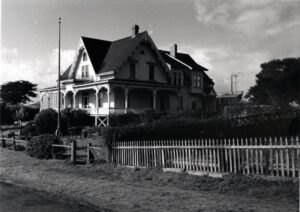The old MacCallum family of Mendocino included not just Alex and Daisy, but also their children, Donald and Jean. We don’t know a great deal about these two. Neither married.

A view of the south and east elevations of the MacCallum House from Albion Street, taken at about the time of Daisy Kelley MacCallum’s death. A flag pole in the front yard was erected in 1942 by Daisy. The southwest corner of the front porch has been enclosed since 1932. A “Queen Anne” style picket fence encloses the gardens to the east of the house. Note the gate in the fence that allowed pedestrians to take a short cut through the garden from Albion Street to Ukiah Street.
Donald was always a quiet one, sometimes described as “odd.” He lived most of his life with his mother in the MacCallum residence or traveled about California with her to resorts and hot springs. He was known to be a “competent businessman,” the owner of a family mining operation. Most endearingly, he was an obliging chauffeur who would drive people wherever they needed to go in his large automobiles. He loved to take ball teams to Ukiah for games, help families to church, and ferry folks to Fort Bragg to catch the train.
Jean was also a quiet type and lived in San Francisco as her Aunt Elise’s companion and assistant. They traveled the world together and devoted their lives to charitable work until Elise passed away in 1951. After her mother died three years after that, Jean was in Mendocino more often managing the real estate holdings and continuing her mother’s good works, including donating the land for Zenith Hill Veterans Cemetery at Hillcrest Cemetery.
Daisy had, however, one other “daughter,” and that was Gwenlian. Technically she was a niece, and she entered the family on the brink of becoming an orphan. Daisy’s husband Alexander had a brother John in Ukiah, who died in 1907. He left a terminally ill wife, Nellie Scott, and an 8-year-old daughter named Grace. In a gesture of goodwill, Daisy wrote Nellie a letter offering to adopt and support the child.
So, Grace moved in with Daisy and became “Gwenlian.” She attended Mendocino schools until she went to a private school for young ladies in San Francisco. At the age of 18, she married Albert F. Hansen in Oakland, and later married a man named Leslie Keith Yonce. She was a fanciful and poetic person, and as she matured, she became a theatrical producer, bringing her original performances to Mendocino, Fort Bragg, and other county venues. A 1936 Beacon piece reported that her stage shows reflected “high standards” and featured Vaudeville units, fashion shows, and kiddie reviews.
However, family interactions got abrasive in 1953 when conflicting wills were presented for the distribution of Daisy’s $747,000 estate upon her death. It took four years to sort things out.
Gwenlian challenged the original will presented by attorney Whitting Welch. She cited a different, earlier will made in September 1944 when Daisy, aged 85, was “in full possession of her facilities,” and which promised Gwen a share of the estate.
She contended that the will presented to the court, with a later date of 1948, and which neglected to mention the adopted niece at all, was not of Daisy’s making. She stated it was written by attorney Welch and daughter Jean MacCallum when Daisy was no longer of sound and disposing mind and memory. Who to believe?
Opposing family members hired lawyers and went to court. Newspapers in Mendocino, Ukiah, Napa Valley, and Santa Rosa closely followed the long, drawn-out litigation. The Ukiah Daily Journal in 1957 noted the estate had grown in value to $900,000. Then, a ruling came down in favor of Jean and Donald. Gwenlian seemed to have lost the bid for her inheritance.
But then…! New evidence was presented. The Santa Rosa Press Democrat headline on July 10, 1958, proclaimed, “Mendocino Woman’s Old Letter Pivot Point In $737,000 Suit!” Gwen came to court with a copy of a letter Daisy had written that promised her one-third of the estate. Written on cheap, yellowed paper, Gwenlian claimed that she had, in the 1920s, copied the original letter, and that this letter was her proof, along with the 1944 will, for her claim. A criminologist and examiner of questionable documents was brought in to testify about its authenticity.
Maybe Judge Lilburn Gibson had a soft heart. Perhaps he knew Daisy and her family history on the coast. Maybe he thought Daisy’s natural children already had enough wealth. Who knows? But in December of 1958 he ruled in Gwenlian’s favor.
The court gave Gwenlian $178,500 in stock securities, which included 1500 shares of Standard Oil, 500 shares of Reynolds Metals, 600 shares of Stauffer Chemicals, and 100 shares of Procter & Gamble.
The natural children of Daisy did okay. Donald got $8,605 and a half interest in household furnishings and real estate. Jean got the same split in furnishings and real estate, plus all the cash, stock, and bonds. The state got $34,000 in inheritance taxes. The attorneys involved received $19,000 and Whitting Welch, who wrote the contested will, got $14,000 as the administrator of the estate.
Gwenlian died at age 85 in Santa Rosa in 1984. She left two children (Betty and Robert), two grandchildren, and five great-grandchildren.
We are celebrating the 160-year anniversary of the Kelley House with this series of articles about the lives of the Kelley and MacCallum families. Next time, we’ll learn about the life of Russell Kelley and his early demise.